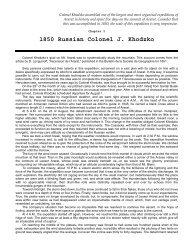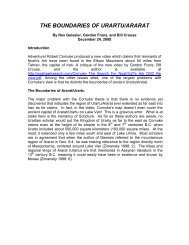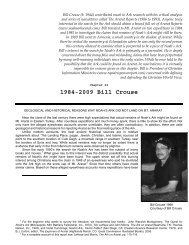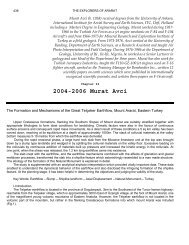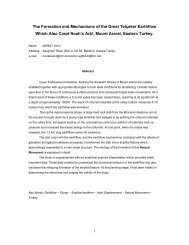1876 British Viscount & Ambassador James Bryce - Noah's Ark Search
1876 British Viscount & Ambassador James Bryce - Noah's Ark Search
1876 British Viscount & Ambassador James Bryce - Noah's Ark Search
You also want an ePaper? Increase the reach of your titles
YUMPU automatically turns print PDFs into web optimized ePapers that Google loves.
154 THE EXPLORERS OF ARARAT<br />
rebuilt by Tiridates, a protégé of Nero’s, under the name of Neronia. When, about A.D. 370, it was again taken and<br />
burnt by the Persians, it is said to have contained a population of 200,000 total, 40,000 of them Jews.<br />
At Aralykh we were received with the utmost courtesy by the officer in command, Colonel Temirhan Aktolovitch<br />
Shipshef, a Mohammedan noble from the Kabarda, on the north side of the Caucasus, and a man of many and varied<br />
accomplishments. At night, it was terribly hot, for we were enjoined to keep the windows shut to avoid the feverproducing<br />
miasma from the adjoining marshes. Even our concentrated solution of carbolic acid, though it was strong<br />
enough to burn a hole in my forehead, did not wholly repel the mosquitoes whom these marshes rear. Concerning<br />
Ararat we had much discourse, the upshot of which was that nobody at Aralykh knew anything of former ascents, nor<br />
of how it ought to be attacked, but that we should have horses and Cossacks to take us to Sardarbulakh [Serdabulak<br />
in later times], a small military outpost high up on the way which leads over the pass between Great and Little Ararat to<br />
Bayazid, and as much farther as horses or Cossacks could go. A day, however, was needed to make preparations,<br />
and while these went forward, we got the heads and spikes of our ice-axes fitted with shafts by a German carpenter<br />
attached to the station, and rambled out under umbrellas over the slope that rose almost imperceptibly to the<br />
southeast, an hour’s walking on which seemed to bring us no nearer to the mountain. It was an arid waste of white<br />
volcanic ash or sand, covered with prickly shrubs, among which lizards and black scorpions wriggle about. We ought,<br />
of course, to have gone—any energetic traveler would have gone—to examine the ruins of Artaxata, but the<br />
overpowering heat and the weariness of the last few days and sleepless nights, which began to tell as soon as we<br />
began to rest, made us too languid even for so obvious a duty. So we dawdled, and panted, and dozed, and watched<br />
the clouds shift and break and form again round the solemn snowy cone till another evening descended and it glittered<br />
clear and cold beneath the stars.<br />
Chapter VI<br />
None of the native peoples that behold from the surrounding plains and valleys the silvery crest of Ararat know it<br />
by that name. The Armenians call it Massis, or Massis Ljarn (ljarn meaning “mountain”), a name which we may<br />
connect with the Masius of Strabo (though his description of that mountain does not suit ours); the Tatars and Turks,<br />
Aghri Dagh [Agri Dagi], which is interpreted as meaning “curved mountain,” or “painful mountain”; the Persians, Koh i<br />
Nuh, “the mountain of Noah,” or, according to Sir John Chardin, Sahat Toppin, which he interprets to mean “the Happy<br />
Hillock.” It has received among geographers the name of Ararat, which the Russian use is now beginning to spread in<br />
the neighborhood, and which the ecclesiastics at Etchmiadzin have taken as the title of a monthly magazine they<br />
publish, only from its identification with the Biblical mountain of the <strong>Ark</strong>, an identification whose history is curious.<br />
The only topographical reference in the Scripture narrative of the Flood is to be found in the words, Genesis viii,<br />
4,—“In the seventh month, on the seventeenth day of the month,” “the <strong>Ark</strong> rested upon the mountains of Ararat,” which<br />
may be taken as equivalent to “on a mountain of (or in ) Ararat.” The word Ararat is used in three, or rather two, other<br />
places in Scripture. One is in 2 Kings xix. 37, and the parallel passage in Isaiah xxxvii. 38, where it is said of the sons<br />
of Sennacherib, who had just murdered their father, that “they escaped into the land of Ararat,” rendered in our



